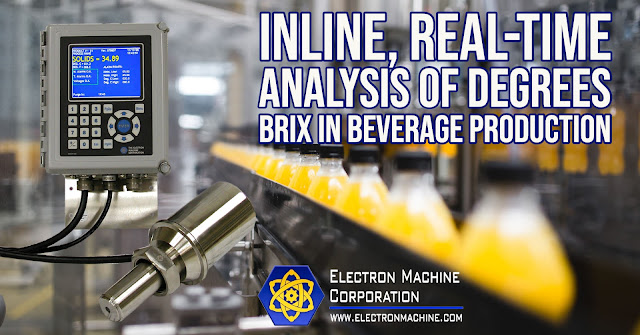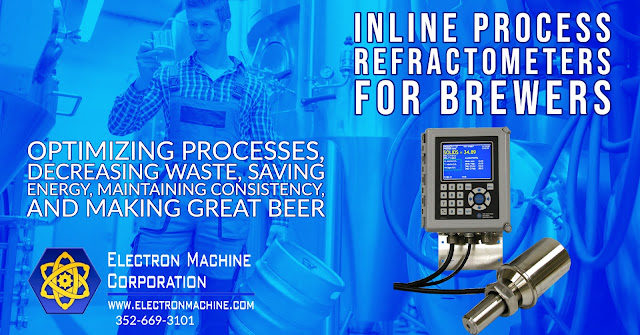This blog focuses on industrial, inline process refractometers and their use in industrial applications. Refractometry is used to measure the refractive index of a substance in order to determine its composition or purity. Posts include information on theory, construction, installation, new products and new markets.
Electron Machine Corporation | Umatilla, FL | PHONE: 352-669-3101 | ElectronMachine.com
The MPR E-Scan™
Inline, Realtime Analysis of Degrees Brix (°Bx) in Beverage Production
The beverage sector creates widely consumed goods while adhering to stringent quality standards. Producers of beverages are responsible for ensuring adequate quality and meet rising customer demands for innovative and consistent flavor. Reliable process control tools are required to make production viable and sustainable and maintain the highest levels of product quality. In this age of sophisticated technologies, it's essential for best practice manufacturing standards.
The degree of Brix (°Bx) indicates the amount of sugar in an aqueous solution. One degree Brix equals one gram of sucrose in 100 grams of solution and suggests the solution's strength as a percentage of mass. Brix monitoring and measurement are critical for various beverages, whether dairy, brewery, wine, soft drinks, or fruit juices.
In the beverage and juice industry, syrups and concentrates are blended with water, or fermented, according to specific recipes, stored in stacking tanks, and finally filled into product-specific bottles or containers. A standard method for Brix testing is a manual process done in a remote lab with samples taken from the process. If a primary component, such as a juice concentrate, does not precisely meet the specifications, or if the blending process itself is incorrect due to incorrect flow control, the entire production run may be flawed. Cross-contamination is another concern. If a wrong product is mixed and bottled due to a poorly controlled phase transition, rejection of the whole batch is the outcome.
The inline refractometer (a robust process control instrument) provides a highly reliable and precise measure of Brix in beverage production. Inline process refractometers are installed in the process piping and continuously measure the Brix value, constantly measuring the definition and differentiation of each product, component, juice, or beverage.
The advantages are clear for choosing inline refractometers. The time-consuming and labor-intensive manual sampling and laboratory analysis are less efficient and less repeatable. The more efficient and reliable solution is the inline process refractometer. These devices offer real-time, inline continuous concentration measurement and cross-contamination protection. Additionally, operators can use their time to perform other critical activities, enabling other time-savings quality improvements.
Electron Machine Corporation
https://electronmachine.com
+1 352-669-3101
MPR E-Scan™ - The World's Most Rugged In-line Process Refractometer
Inline Process Refractometers for Pulp & Paper Mill Applications
Inline Process Refractometers for Brewers
Beer brewing and branding are all about consistency. Process monitoring is thus vital. With Electron Machine inline refractometers, you'll have less waste, use less energy, spend less money, and achieve better beer.
While some breweries still use manual sampling and lab analysis, the trend is adapting inline monitoring and automation. Laboratory analysis is part of R&D. It reveals how different substances or methods affect qualities like flavor and fragrance. Laboratory analysis is vital in research as it provides an understanding of chemistry. However, the utility of sampling and analysis can be limited in manufacturing due to costs and delays when the lab findings indicate the issue. Slow sample timing results in possible lost production and waste. Similarly, because the sample is a snapshot of the process, it cannot provide feedback control, timely alarms, or indicate trends.
The angle of refraction of light in the process medium determines the refractive index (RI), which the inline refractometer computes important process variables continually. Electron Machine inline process refractometers will calibrate to Brix, Gravity, Density, or Plato and withstand CIP/SIP cleaning and rinsing operations.
Process refractometers have a quick response time which provides critical information in all stages of beer production. Examples of applications for inline refractometers that arise throughout the brewing process:
- Grain mashing - Refractometers measure mash concentration in the output pipe water.
- Lautering - While the spray water rinses the grains, it completes the sugar extraction process and produces clear wort. The refractometer continuously measures this concentration to determine the rinsing breakpoint, saving water and electricity.
- Wort boiling - Refractometer installed directly on the wort boiler continuously measures wort strength / specific gravity, allowing the brewer to determine the required concentration.
- Rousing or Swirling - Solid particles are removed from the bitter wort in a vortex. The vortex causes the leftover particles to thicken and form sludge. The solids removal uses refractometers placed before or after the vortex for a clear bitter wort for the next phase.
- Cooldown - A heat exchanger cools the wort, recovering some of the energy needed to boil it. Refractometers are affixed to the cooler's outflow to ensure the bitter wort has the proper level of dissolved solids.
- Fermentation - Yeast ferments wort to produce CO2 and alcohol. The specific gravity (or relative density) of the fermented liquor is determined using refractometers. The alcohol concentration directly correlates between the initial wort density and current density, so the refractometer can closely monitor fermentation. It gives brewers real-time information into the process, allowing them to predict fermentation completion.
- Filtration and Aging - The beer is rested after fermentation to settle the used yeast. But several filtration procedures are used to refine the beer as the last chance to impact beer quality. Refractometers assist in measuring bitterness, flavor, fragrance, foam stability, clarity, alcohol, and gas percentage.
- Filling and CIP (Clean-in-Place) - With the refractometer, you can quickly swap between items or batches and easily detect production from cleaning products.
In summary, refractometers assist brewers in optimizing processes, decreasing waste, saving energy, and maintaining consistency, and making great beer.
Electron Machine
352-669-3101




